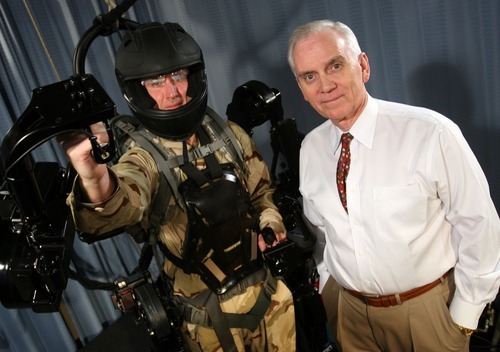This is an archived article that was published on sltrib.com in 2011, and information in the article may be outdated. It is provided only for personal research purposes and may not be reprinted.
What if diabetes patients could precisely monitor their carbohydrate intake as they eat? They would be able to calibrate their insulin intake to ensure glucose levels remain in a healthy range, according to University of Utah engineer Richard Brown.
Along with a physician collaborator, Brown has invented such a device, a programmable tray with built-in scales that could potentially improve the quality of life for millions of chronically ill people and control health care costs.
His device is invention No. 5,000 developed on the U. campus — disclosed 45 years after Brown's predecessor filed the U.'s first invention disclosure. U. President Michael Young used the occasion to honor the university's most prolific inventors at a gathering Tuesday in Fort Douglas.
"The biggest part is they do extraordinary stuff, but how do you get that into the lives of ordinary people? The answer is partnerships with the business community," Young said. "Our mantra is getting research from the lab bench to the bedside. You can cure cancer, but if it stays in a test tube it's little more than interesting conversation at a cocktail party."
Young showered praise on the U.'s busiest inventors, who between them have filed more than 300 invention disclosures, the first step toward patenting an idea.
The U. has gained a reputation as an invention hotbed that dates to 1965, when then-engineering dean Wayne Brown filed the first invention disclosure for a "continuous electroplating apparatus."
"It's great to be here at a university that carries the research results into products, so they benefit humanity. The University of Utah is very efficient at commercializing its technology," said Richard Brown (no relation to Wayne), who has been dean since 2004. "A lot of the [engineering] research is connected to medicine. This is a wonderful interdisciplinary collaboration we have."
When it comes to patents, Brown himself is no slouch. He holds 17 and has started four companies, most recently the U. spin-offe-SENS.
Richard Brown worked with Intermountain Health doctor Joel Ehrenkranz to develop the most recent invention, which is designed to help diabetics time insulin injections to maintain optimum glucose levels. When glucose is too high, this fuel for the body wreaks havoc and damages tissue. Keeping it at a healthy level could mean the difference between living a normal life or blindness, amputation and ICU stays.
Brown's invention is a smart food service tray.
"The idea with the tray is you tell it what's on each of the scales and as you eat, it tracks the weight. It knows from a nutritional database how many carbohydrates per gram is contained in the food," said Brown, a U. graduate who served 19 years on the University of Michigan faculty before returning to the U. in 2004. The tray communicates with an insulin pump to release the medicine at the right time.
"That way the insulin comes in as you eat, just like the way a healthy pancreas would work," Brown said. "It plots grams of carbohydrates, fat and protein as you eat. The biggest application could be in dieting."
The product would be tested in hospitals, but Brown believes the consumer market would be much larger. The U.'s fabulous five
This year the University of Utah filed its 5,000th invention disclosure, based on work by Richard Brown, dean of engineering. To date the university has filed 4,344 patent applications, secured 1,661 patents and completed 608 technology licences with companies. Since 2005, more than 100 companies have been started using U.-developed technologies. Here are the most prolific inventors at the state's flagship university:
Bioengineer Joseph Andrade developed biochemical sensors and is now promoting science awareness in his role with The Leonardo.
Medicinal chemist Glenn Prestwich is a leader in faculty entrepreneurship engaged in drug discovery, cell therapy and tissue repair.
Metallurgical engineer Jan Miller, a professor in the College of Mines and Earth Sciences, is a leader in mineral processing.
Mechincal engineer Stephen Jacobsen is a robotics pioneer who helped launch Sarcos at Research Park.
Biologist Baldomero "Toto" Olivera developed new pain medication from the venom of cone snails.



